
Everytime we have a dimsum lunch we tend to order too much - not that I'm complaining. So we usually have a very light dinner afterwards or none at all. Last Saturday was one like this, me and my husband were still partially full and we couldn't possibly have our usual dinner. I decided to fix something light with the ciabatta I picked up from the supermarket earlier.
Bruschetta is a favourite starter in Italian restaurants. In essence, it's garlic bread with toppings like tomatoes or anchovies or aubergines, etc. Although this garlic bread uses olive oil instead of butter. The one I made that night is the standard bruschetta you find in restos with tomatoes and basil leaves on top. Very easy to make though quite refreshing to have. Biting on the combination of crusty garlicky bread soaked in olive oil with fresh tomatoes and basil on top is simply divine. Bruschetta
slices of crusty bread (ciabatta, baguette, etc.)
olive oil
ripe tomatoes
fresh basil leaves
garlic clove - peeled and sliced in the middle
salt and pepper
- Halve tomatoes crosswise. Scoop out the seeds, discard. Chop roughly.
- In a bowl, put the tomatoes and season well with salt and pepper.
- Tear basil leaves and mix with the tomatoes.
- Toast, grill, or broil the bread until well browned on both sides.
- While still hot, rub the cut side of the garlic on the toasted bread.
- Drizzle or brush olive oil on top.
- Spoon mounds of tomatoes on top of the toasted bread. Serve immediately.
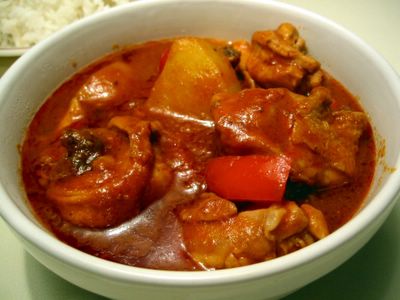
I've done several recipes for caldereta with different takes on this spicy dish. But I always comeback to this version which is the simplified amalgamation of most of the calderetas I have tasted. Goat's meat is traditionally used in the Filipino caldereta. The spiciness lends well and sort of masks the 'gamey' taste of the goat's meat and since it's quite tough the dish benefits from the long simmering making the sauce quite rich. Like any popular dish, it's got lots of variations and mine here uses chicken instead of red meat. I tone down the spiciness if I know my children are having it otherwise I add the full gamut of fresh chillies and Tabasco sauce. Also for everyday use I often skip the chorizo and olives. This recipe can be adapted for red meats as well such as goat's meat, mutton, beef, lamb, etc. The only difference that I could think of is that you have to marinate the red meat longer and obviously simmer/cook it for a longer time.
Chicken Caldereta
1 kg chicken - cut into serving sizes
1/3 cup vinegar
2 tsp salt
1/2 tsp black peppercorns - lightly cracked with mortar and pestle
1/2 Tbsp minced garlic
1 medium onion - chopped
oil for frying
500 g passata (tomato sauce)
1/4 cup coarse grained liver pate (or mashed cooked liver or 85gm can of liver spread)
125 g chorizo - chopped into 1/2-inch slices [optional]
1/2 bell pepper - seeded and sliced
1 green or red fresh chilli [optional]
hot chilli sauce (or Tabasco)
1/3 cup bottled olives - drained [optional]
1/3 cup peas (fresh or frozen)
250 g potatoes - peeled and quartered
1/2 cup grated cheddar cheese
- Mix vinegar, salt, garlic, and peppercorns in a bowl. Add chicken pieces, mix well. Marinate chicken for at least 2 hours.
- In a big pot, heat oil for frying. Drain chicken from marinade and brown briefly in the oil in batches. Set aside.
- Remove oil from the pot but leave about 2 Tbsp. Heat up again and saute the onion on medium heat until soft and translucent (about 4-5 minutes).
- Scoop out the garlic and peppercorns from the marinade and add to the onion. Saute for a few minutes.
- Add in the browned chicken, stir for a minute.
- Add the rest of the marinade, stir and cook for about 30 seconds.
- Stir in the passata and bell pepper. Bring to boil then turn down the heat.
- Add the chorizo and fresh chilli (if using). Simmer until meat is almost done.
- Stir in the liver pate and mix well to combine.
- Add potatoes and peas. Simmer until potatoes are cooked.
- Add grated cheese, mix well until cheese has melted.
- Taste sauce and correct seasonings adding hot chilli sauce if preferred.
- Add olives just before removing from heat. Serve warm.

If you want a sweet dessert for the current hot summer days why not try this staple of Chinese dimsum restaurants. It's basically cold ginatan with sago and fruits. You can vary the fruit, instead of honeydew melon you can use watermelon or rock melon or other fruits you fancy. We had this when we had a barbecue at a friend's house. It was so refreshing to have a very cold bowl of coconut soup dotted with floating pearls of sago and the fresh crunchy bite of the honeydew.
I got sago cooking tips from Wendy's Eupho Cafe and indeed the sago I made was well cooked through (no white thing in the middle) , soft but a bit chewy and not at all mushy. So thanks Wendy for that tip. This is so easy to make even kids can do it.
Honeydew Sago
1 x 400 g can coconut milk
3/4 - 1 cup water
3 Tbsp sugar
pinch of salt (about 1/8 tsp)
1/3 cup small sago pearls
honeydew melon - peeled and chopped into small pieces
*To cook sago:
- Boil about 3 cups of water in a saucepan. Add in sago pearls and bring to boil.
- Once it boils, cover saucepan and turn off heat. Leave for 20 minutes.
- Remove the lid, stir the mixture, turn on the heat and bring it to boil again.
- Once it boils the second time, cover again, turn off the heat and leave covered for 10 minutes. The sago should be cooked by now.
- Drain the sago from the hot water and rinse. Soak in cold water (to stop it cooking further). When completely cool drain again and set aside.
*To cook coconut milk soup:
- Put coconut milk in a saucepan. Add in enough water to dilute it. This will depend on the brand of coconut milk you got. If it's very thick then you add up to 1 cup water. If a bit thin then you reduce the water accordingly.
- Add sugar and a pinch of salt.
- Stir to mix and bring to boil for a few minutes until sugar is completely dissolved. Taste the mixture to see if the sweetness is acceptable, if not, add more sugar.
- Remove from heat and cool completely. Chill in fridge. This should be served very cold.
*To assemble:
- Put in desired amount of sago and chilled coconut soup in a bowl. (The coconut soup might separate when left standing. So stir it first before ladling into bowls.)
- Top with some honeydew melon. Serve.
Variation: Add in pandan leaves in the coconut soup mixture before boiling. Remove the pandan after taking coconut soup from heat.

Originally, my entry would have been Leche Flan - the creme caramel version of the Philippines. But decided not to, since I mixed up my aunt's instructions on the recipe with me putting in 2 cans of condensed milk and 1 can evaporated milk instead of the otherway around. Result was a very sweet dense flan, almost like a dulce de leche. Well scrap that, I just have to find a way to use it up. Enter this savoury dish of quail eggs which is quite easy to make. The recipe I adapted from Huang Su-Huei's Chinese Cuisine cookbook was a bit on the salty side so had to reduce the soy sauce and eliminate the salt. Other than that it was quite nice and I love the way the baby button mushrooms and the eggs mimic each other's shape and colour. Can you guess what I forgot in the presentation? I should have put this in a bed of steamed green veggies. But in my haste and excitement I forgot and only remembered when me and my husband began eating it. Being mostly eggs, it was quite rich so it needed the foil of something bland. Also I think it would benefit from being only one of a group of dishes on a lunch/dinner spread. It seems quite rich just on its own.
I'm sure this version of the IMBB would have a lot of participants due to the universality of the theme (which in case you didn't notice is *eggs*). Thanks is in order to Viv of Seattle Bon Vivant who thought up the theme and is hosting this edition.
Braised Quail Eggs with Mushrooms
24 quail eggs
1 Tbsp soy sauce
2 cups oil for deep frying
1 green onion - cut into 1 1/2 inches length
2 cups canned or precooked fresh baby button mushrooms*
*Sauce:
1 1/2 Tbsp soy sauce
1/2 Tbsp cooking wine
1/2 tsp sugar
freshly ground black pepper
1 cup stock
*Thickener:
1 Tbsp cornstarch
1 Tbsp water
- Hard boil the quail eggs by lowering them in a saucepan with gently simmering water. Cook for 5 minutes. Turn off heat. Remove hot water from saucepan and then fill up with cool tap water. Replace water again once it gets warm again. This is to stop the eggs from cooking. Drain eggs from water and cool completely.
- Peel eggs, mix and marinate with the soy sauce for about 15 minutes. Drain.
- Combine all ingredients for sauce and thickener in separate bowls.
- Heat 2 cups oil in a wok or saucepan and deep fry the marinated quail eggs for a few minutes or until golden brown. (Some of the quail eggs may balloon and burst at this point) Remove from oil and drain. Set aside.
- Heat 2 Tbsp oil in the wok and saute green onions until aromatic.
- Add mushrooms and sauce; stir fry for about 2 minutes.
- Stir in quail eggs. Then the thickener. Stir to mix.
- Best to serve on top of steamed or blanched vegetables like broccoli, pak choi, cabbage, etc.
*Note: You can precook mushrooms by cooking or steaming it in simmering water.
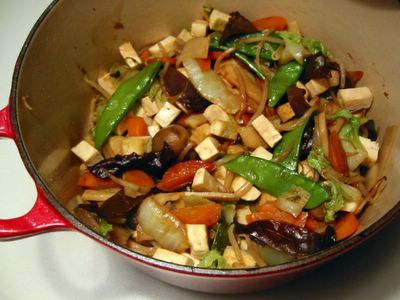
For me, after work dinner at home usually consists of some meat stew and steamed vegetables with the occassional rice. Sometimes I hanker for a more 'sophisticated' veg dish and try to whip up something quick. I almost always end up doing a Chinese stir fry because it's so easy to cook in the shortest time possible. But this dish involves braising under cover not just plain stir frying. I love the combination of the ingredients with the simplicity of the sauce it uses.
This dish is also known as 'Buddha's Delight' or Lo Han Zhai that normally uses 18 different items which I'm not sure if it represent the 18 arahats or 18 disciples. Whichever it symbolises, this Chinese dish definitely has Buddhist connections. Nowadays the use of six to eight vegetables is the more usual practice. I adapted this from the Chinese Cookery Secrets cookbook of Deh Ta Hsiung. I adore the succulent straw mushrooms but still hated the stink of bamboo shoots. Despite washing and draining it several times it still have that smell that I abhor. So probably next time I'll replace it with something else. Also the original recipe tells you to stir fry in a wok first then transfer to a casserole. I decided to do away with the wok and stir fry right in my cast iron pot which I think is okay. Also, if you have ready made seasoned oil in your cupboard you can eliminate the ginger. It's just for spicing up the oil which is entirely optional. So this is my take on the Buddha's Delight ...
Buddha's Delight
(Vegetarian Casserole)
1 cake tokwa (beancurd) - diced into 1/2-inch cubes
cooking oil for frying
2 small ginger slices (optional)
5 g [about 1 big piece] dried black fungus (wood ears)
85 g [3/4 cups] bean sprouts
115 g [about 3-4 stems] Chinese cabbage - cut into small pieces
1 small carrot - cut diagonally into thin pieces
50 g [1/2 cup] sitcharo (mangetout or snow peas) - topped and tailed
1 tsp salt
1/2 tsp soft brown sugar
85 g [1/2 cup] sliced bamboo shoots - rinsed and drained
85 g [1/2 cup] straw mushrooms - drained
1 Tbsp light soy sauce or oyster sauce
3 Tbsp stock
few drops of sesame oil
- Soak black fungus in warm water for 20 minutes, rinse and drain well. Cut into bite size pieces discarding any hard bits.
- Mix stock, soy sauce or oyster sauce in a small bowl. Set aside.
- Heat about 2-3 Tbsp oil in a non-stick pan and fry one small slice of ginger (if using) until it turns brown. Discard ginger then fry bean curds in the same oil in pan until light brown. Drain and set aside.
- Heat about 2 Tbsp oil in a casserole or medium sized pot. Again fry one small slice of ginger (if using) in the oil until the ginger turns brown. Discard ginger.
- Stir fry the Chinese leaves in the pot for about 1 minute then add the carrot, mangetout and bean sprouts with the salt and sugar. Cook for about 1 minute.
- Add the black fungus, bamboo shoots, straw mushrooms, and stock mixture. Blend well and bring to boil. Then reduce heat and cook under cover for 5 minutes.
- Lift cover and add sesame oil. Stir for a few seconds more and then serve.
Note: If you must wait for quite sometime before serving it, do not put the lid tightly on the pot. Keep it slightly ajar to prevent the vegetables from overcooking and discoloring.

This is probably the worst food blogging event I've done. Not the theme of course (which by the way is tart), but my entry. I just can't hack this tart making more specifically the tart base. Why my first attempt was a resounding disaster because my tart almost burnt to cinders. The second one almost met the same fate. :sigh: My ancient oven seems to have a lot of hot spots.
The biscuit-like base was actually good which should be crunchy and on the brittle side but it got sooo hard when I made the mistake of chilling the whole thing. I was already contemplating on borrowing my neighbor's chainsaw to give myself a slice. Then there's the case of the pastry cream (creme patisserie) which tasted sort of ... ah ... 'cheap'. It must be the vanilla or maybe I should have used single/light cream instead of milk. I don't know, it just doesn't taste right. The only consolation I have is the sight of the fresh fruits arranged glistening on top. Really nice.
It only proves that I really learn a lot from these food blogging events. Lesson for today is - buy a new oven ! :lol:
[TV announcer lilting voice] This edition is brought to you by Red Beard at Life in Flow, A French Kitchen in Burgundy by Anne Willan for the tart base and French Cooking Made Easy (it's not bloody easy!!) by the Australian Women's Weekly. If you're masochistic enough to want to torture yourself, here's the recipe:
Fresh Fruit Tart
*For the sweet pastry (pate sucree):
1 1/2 cups flour
1/2 cup sugar
3 egg yolks
1 tsp vanilla
100 gm chilled butter
*For the pastry cream (creme patisserie):
1 1/4 cups milk
3 egg yolks
1 Tbsp flour
1 Tbsp cornflour
1/4 cup caster sugar (superfine)
1 tsp vanilla [optional]
*Topping:
sliced fresh fruits
3 Tbsp apricot jam
1 Tbsp water


*To make the base:
- Preheat oven to 200°C/fan 180°C/400°C/gas mark 6.
- Mix flour and sugar in a bowl. Cut in butter with a pastry blender or two butter knives until they resemble coarse breadcrumbs.
- In another bowl, gently mix egg yolks and vanilla. Add little by little into the flour mixture while tossing and mixing with a fork.
- Press and squeeze the mixture into a ball (if needed sprinkle a few tablespoon of water). Wrap in plastic film and refrigerate for 30 minutes.
- Take the dough from the fridge and roll out into a 13-14 inch circle. Lay out on a 10-inch tart pan and trim the edges. Prick the base all over with fork.
- Bake blind for 10 minutes. [To bake blind: cut parchment paper on tart base. Place baking beans or ceramic beans on top.]
- Remove beans and parchment paper and bake again for about 7 minutes. Remove from oven and cool completely.
*To make the pastry cream:
- Boil milk in a saucepan. While waiting for it to froth over, mix egg yolks, flours, sugar, and vanilla in a heatproof bowl.
- Once the milk boils, pour into the flour mixture in a thin stream while whisking constantly.
- Transfer back into the saucepan and let simmer until thick while stirring all the time.
- Remove from heat, put a moistened parchment paper on the surface (to prevent a film/crust from forming on top). Cool completely.
*To assemble:
- Heat apricot jam and water in a saucepan. Strain and cool.
- Spread the pastry cream evenly on the tart base. Arrange sliced fresh fruits on top.
- Brush the apricot jam mixture on the fruits using a pastry brush. Serve.
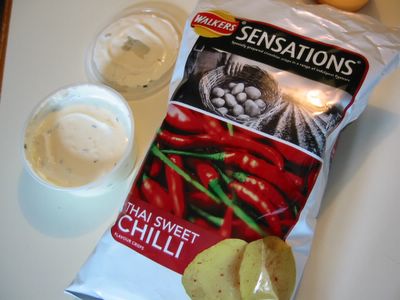
A comment in one of my snack posts last month reminded me of my most favourite crisps (that's potato chips for Pinoys and 'Merkins) and dip combination. It's been about 6 months since I last had these so I don't think anyone would mind if I have one now, would you? ;)
Thai Sweet Chilli crisps from Walkers was already my favourite when it first came out a few years ago. But I discovered that when you paired with a sour cream and chives dip it was out of this world. Labeeeett!! It had the right blend of sweetish very mild spicy hot flavour with the usual excellent crunch of crisps that Walkers does well. Once you dip it in that sour cream concoction the spiciness of the crisps is countered by the bland coolness of the dip that gives an ever so slight sweetness to the combination. Oh, so heavenly ... hmmm, hmmmm, hmmm!
I could finish one whole big bag of this in one sitting but only with the sour cream dip. I've always loved contrasts in food. Something about the balancing of flavours and textures appeals to me. How about you? What's your favourite crisps or potato chips combo?
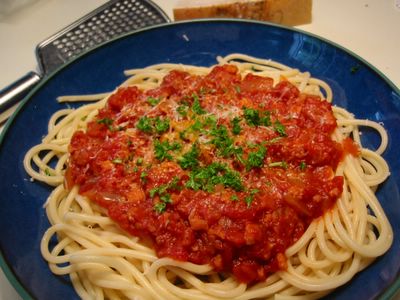
That night my son wanted a pasta dish. He suggested something cooking something else because we were quite tired of spag bol, baked pasta, or pesto. Flicking thru my cookbooks, I spied a familiar title that I have tried several times in restaurants before but have not attempted to replicate. Upon seeing it, I was quite impressed for I remembered this to be a quite tasty one but the ingredients were few and uncomplicated that can be found in any kitchen larder. I've seen most types of pasta used for this ranging from bucatini, rigatoni, penne, to even farfalle. This is quite versatile so, unless you're an Italian pasta purist, use whatever pasta you have. The Food of Italy cookbook provided the recipe that I adapted. It was a fast, tasty and easy dish to make though I had a hitch with the parsley. At the end it should have been stirred in. But I forgot! So as you can see it makes a nice garnish as well. ;)
Spaghetti Amatriciana
1 x 400 g can of chopped tomatoes
1 Tbsp double-concentrated tomato puree (tomato paste)
150 g chopped pancetta or smoked bacon
1 Tbsp olive oil
1 tsp minced garlic
1 small onion - chopped
1/8 tsp dried chilli flakes (or to taste)
2 Tbsp finely minced fresh parsley or 2 tsp dried parsley
salt and pepper
grated parmesan cheese
300 g dried spaghetti
- Heat olive oil in a heavy bottomed saucepan. Fry pancetta in medium heat until brown.
- Add onion and cook until soft.
- Tip in the garlic and chilli flakes. Stir and cook for about 1 - 2 minutes.
- Add in chopped tomatoes, tomato puree, and season well with salt and pepper.
- Bring to boil and simmer for about 15 minutes.
- Stir in parsley in the sauce and cook for another minute. Taste and adjust salt and pepper if necessary.
- While the sauce is simmering, cook spaghetti in boiling water until 'al dente' (about 11-12 minutes). Drain and set aside.
- Add cooked spaghetti to the pan and mix until well covered evenly by the sauce. Serve onto serving bowls and sprinkle parmesan cheese on top.
Note: You may also serve it with the sauce on top of the pasta as seen in the photo above.
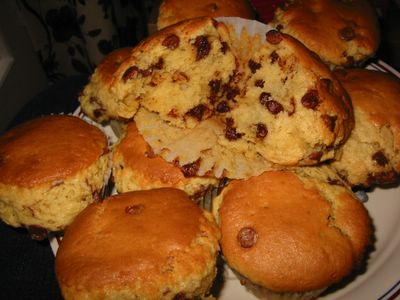
Most of my recipes here are 'basic', you know ones that are basis of endless variations depending on availability of ingredients, cook's mood, or customer's (ones who will eat it) preference. That's always been my intention, to record all my basic recipes first then do the variations afterwards. I have a running list in my head of basic recipes I will post here. One of them is this chocolate chip muffin. I waited sometime because I was looking for a recipe that would do better than what we sampled over the years.
Most of the recipes we tried tasted good but the consistency of the batter is not thick enough thus, making the chocolate chips to sink to the bottom. More often the muffin would result in some kind of a layered cupcake. All chocolates at the bottom with all the cake batter on top. This is the first one we had where the choc chips were more or less evenly distributed throughout. I adapted this from Peter Shaffer's The Genuine American Cookie & Muffin Book. Try it, you'll love it. :)
Chocolate Chip Muffins
350 g [2 2/3 cups] plain flour
200 g chocolate chips (plain or milk)
1 Tbsp baking powder
1/2 tsp bicarbonate soda (baking soda)
1/2 tsp salt
2 eggs - beaten
200 ml [heaping 3/4 cup] plain natural yoghurt
215 g [1 cup] soft Demerara sugar
115 g [1/2 cup less 2 tsp] butter - melted
2 tsp vanilla flavouring
- Preheat oven to 190°C/fan 170°C/375°F/gas mark 5. Grease or line a 12-hole muffin pan.
- Combine flour, baking powder, bicarbonate of soda, and salt in a bowl. Mix well.
- Add in chocolate chips and mix.
- Combine melted butter and sugar in another bowl. Beat until well combined.
- Add yoghurt, eggs, and vanilla.
- Fold butter mixture into the flour mixture. Do not overmix.
- Put in 10 of 12 muffin pans. Half-fill the remaining 2 with hot water to avoid burning the pan and give moisture while baking.
- Bake for 20-25 minutes or until metal skewer poked in the middle comes out clean. Do not overbake!
- Let stand for a few minutes in the pan, turn out and cool on a rack.
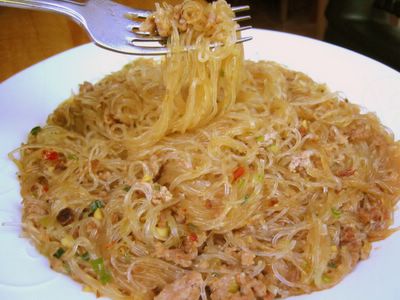
Here's one noodle dish that's so easy to make and with few ingredients. You just need some sotanghon (aka bean thread noodles or glass noodles), a little minced pork, some chilli bean sauce, soy sauce, garlic, green onion and you're done! My blogging friend Stel rightly pointed our to me that this is actually the Szechuan dish called Ants Climbing A Tree. Gosh, I didn't know that. :facepalm:
I adapted this from the Chinese Cuisine cookbook by Huang Su-Huei. Adjustments were made to the soy sauce (it was originally quite salty) and the chilli bean sauce (too hot for me) and eliminated the salt. Other than that it was easy peasy to make. Previously, I soak the sotanghon but I stopped doing that to keep it from getting overcooked since I simmer it in the stock anyway for a few minutes.
Pork Chilli Noodles
100 g sotanghon (bean thread or glass noodles)
125 g [1/2 cup] minced pork
2 Tbsp chopped green onions
1/2 Tbsp chopped ginger
1/2 Tbsp chilli bean sauce
1/2 Tbsp soy sauce
1 tsp sugar
2 cups stock
2 Tbsp cooking oil
Soak the sotanghon in water until soft (about 20-30 minutes). Drain. Cut to desired lengths.- Mix stock, soy sauce, and sugar in a bowl or container. Set aside.
- Heat oil in wok. Stir-fry pork for about 3-4 minutes. (Optional) Add about 1/3 cup hot water or stock and simmer pork until water evaporates. This is in case you want the minced pork to be tender.
- Turn up heat and add green onions, ginger, and chilli bean sauce. Stir fry for about 1 minute or until green onion and ginger becomes aromatic.
- Add stock mixture and sotanghon. Bring to boil then turn heat to low and cook for about 3-4 minutes or until the liquid has almost completely evaporated. (Optional) While cooking, cut sotanghon to desired length once soft enough.
- Dish up and serve.
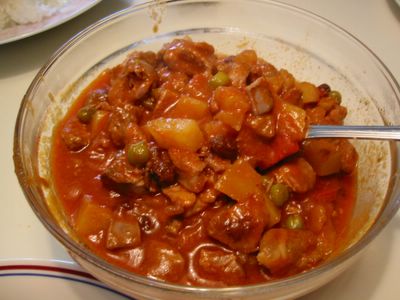
I haven't cooked menudo for a long time, actually it was years ago when I last did. This is all to do with pork liver which is a required ingredient here (if it doesn't have liver I don't consider it menudo). Pork liver in the UK really are stinky (most of the time). No matter how much I washed it before cooking, right after I stir it in the pot it starts to stink. So much so that more than half the time I have to throw away the whole lot. What a waste! I don't know why they stink here. In the Phils and in Hong Kong I never had this problem. Could it be the way pigs are raised here? Or the handling at the abbatoir? I really am clueless.
Anyway, I had some chicken liver to use up and thought of using it in menudo. It was a great addition. The taste wasn't as strong as pork liver but it will do. This recipe is how menudo is cooked in my mother's family, rich and a bit sweetish with the addition of the cheese and raisins. They are actually optional but you should at least try it with them.
Menudo
500 g pork - cut into 1/2-inch cubes
125 g chicken or pork liver - cut into 1/2-inch cubes
1 Tbsp oil
1/2 Tbsp minced garlic
1 medium onion - chopped
500 g passata (tomato sauce)
1 small red bell pepper - deseeded and cubed
2 Tbsp soy sauce
salt and pepper (to taste)
1 1/2 cup diced potatoes
1/2 cup diced carrots (optional)
1/2 cup frozen peas
1/3 cup raisins
1/3 cup grated cheddar cheese (optional)
- Heat oil in a saucepan or pot. Saute garlic and onion in low-medium heat until onion is soft and translucent.
- Stir in pork, cook for a minute. Add soy sauce, stir and cook for another minute.
- Add the passata, bell pepper, salt and pepper to taste.
- Bring to boil and then bring down the heat to low. Simmer until pork is almost cooked - about 40 minutes. If it's drying up too much add hot water a little at a time.
- Mix in the liver, potatoes, and carrots (if using). Turn up heat and cook until potatoes are almost cooked about 5 minutes.
- Add peas and raisins, cook for 2-3 minutes or until peas and potatoes are thoroughly cooked.
- [Optional] Add cheese, stir and remove from heat. Serve warm.
It's been a while since I blogged. Me and my family were on a driving holiday to Switzerland last week and it's only now that I got to sit down and type up something for this food blog. I will be posting our travel iteneraries in my other blog - soon. But on the food front it was not quite as exciting.
We just passed by France, stopping at Reims to sleep and tour around for a few hours. I didn't get a chance to visit a local market or eat a restaurant. Three kids were with us who were turning up their noses on things like pig's trotters, sausages or anything that looked different. Ay ya yay!! 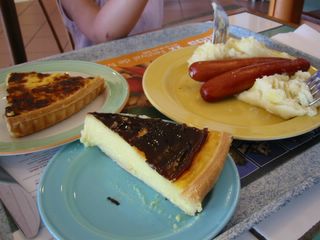
I did notice that roadside food in France is so much better than in the UK. They're expensive as well but we had one of the best quiche, egg flan, and mash potatoes at a roadside cafe in the Jura region.
High prices in Switzerland kept me from eating at proper sitdown restaurants which is a shame 'coz Shatzli suggested lots of food to try. I even printed out all the emails she sent me as a guide but I only tried a few. Oh well, all's not lost because my sister lives there now so there would definitely be more chances for me in the coming months/years when I come back to visit. 
One of the highlights of our trip was a visit at the Nestle Cailler chocolate factory in Broc. We were shown a 'romantic' documentary on how the company was formed. Then led by a guide on sections of the factory while explaining the intricancies of chocolate making. Did you know that Cailler made the first milk chocolate? The lady guide said they only use fresh milk from the Gruyere area and are used in the factory within 24 hours of milking from cows. Unlike some chocolate makers who use powdered milk. It is the only Nestle Cailler factory and they only export 40% of their output which explains why their products are not very common outside of Switz. After the short tour we were led to the tasting room where an array of the complete range of Cailler chocolates were laid out for us to sample. Yes you can eat as much as you like!! I got really excited over seeing chocolates everywhere. Yum! See picture above of what we had. 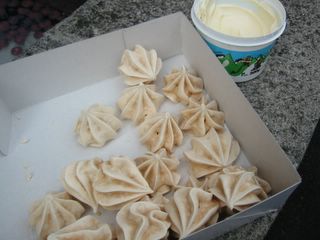
Most of the time we ate in fastfoods and Migros supermarket - they're the most affordable. Occassionally we indulge in some really rich snacks and desserts. Above are meringues (or what's left of it) and heavy cream from the small cute village of Gruyere. Shoplady said to eat it by dipping the meringues in the cream and scoffing it down. Double cholesterolic calorific expialidocious !! But they were divine! Haha. I just forgot all about diet or high sugar level that day. 
Above are fondue pots and cooker for sale in the same shop. No fondue or raclette for me. :(
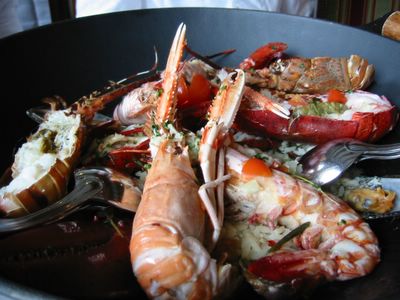
The one time we went to a proper restaurant was at the Restaurant du Lac de Bret. Setting of the place was beautiful. We sat by a picture window overlooking the small picturesque lake of Lac de Bret. Seafood was their specialty so it was just natural to order that. It was so fresh that we didn't realise the lobster in the aquarium that greeted us was our dinner! Poor chap but he was delectable. I couldn't remember the name of the dish we had but as you can see above it was served in a cast iron wok. The seafood (lobster, giant prawns, mussels, and langoustine) was steamed/cooked over long grained rice which was in turn cooked in stock and spices. The flavouring was simple and subtle which was meant to bring out the delicious freshness of the seafood. It was very very good ! Don't ask about the price though I don't want to spoil the memory. 
We visited the small delightful village of Kandersteg and had a happy 'accident' of being in a small brasserie-like restaurant (Aux Chalet View) where we had nice soups, delish strawberry tart (above), and the traditional Swiss rosti with bratwurst (below). First daughter liked the latter. She said rosti was like hash brown while the sausage (bratwurst) was excellent. It's probably their proximity to Germany why all the sausages we had in Switz, whether from a street stall or a supermarket or a restaurant, were all superb. 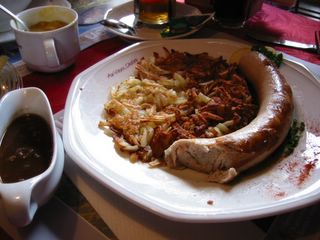
I didn't fare well foodie wise, why I didn't even get the chance to taste Swiss wine. A friend said they have excellent 'young' wines which are best to have within a year of bottling as they don't keep well through the years. Never mind I'll make sure my next time will be better.



















